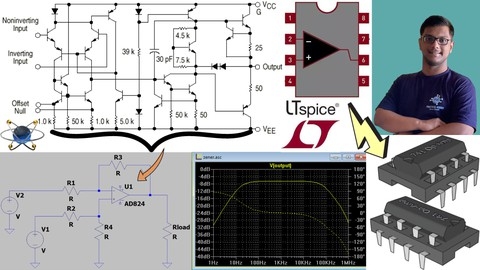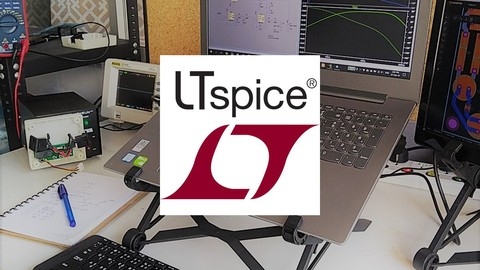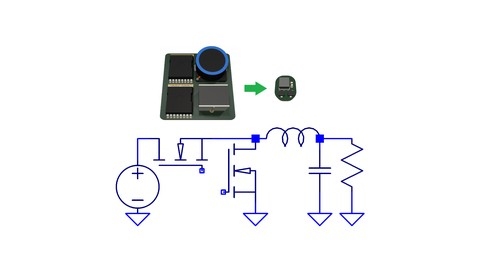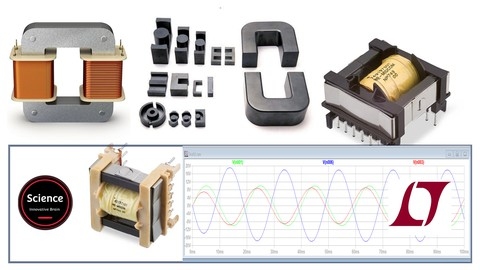If you’re looking for the best LTspice courses on Udemy, you’ve come to the right place.
LTspice is a powerful circuit simulation software, but mastering it can be a challenge without proper guidance.
In this blog post, we’ll explore the top LTspice courses on Udemy that will help you unlock the full potential of this versatile tool.
LTspice Tutorial for Beginners - Let’s Simulate Electronics!
Best Udemy course for mastering LTspice simulations and circuit analysis with comprehensive coverage of time-domain and frequency-domain analysis.
You’ll start with an introduction to LTspice and learn how to perform time-domain simulations like transient analysis and parameter sweeps.
The course dives into initial conditions, piecewise linear sources, and arbitrary voltage sources.
You’ll also learn how to measure and analyze simulation results.
Moving on, you’ll explore DC operating point analysis and different types of DC sweeps, including temperature sweeps.
The course covers DC transfer function analysis, which is essential for understanding circuit behavior.
Frequency-domain analysis is a crucial aspect, and the course covers the Fourier theorem, Bode plots, small-signal transfer functions, and Laplace transforms.
You’ll learn how to perform AC analysis and interpret Bode plots.
The course delves into LTspice’s netlist and SPICE syntax, enabling you to create and modify circuit designs efficiently.
You’ll learn how to import third-party models, such as the 1N4007 diode model, and create hierarchical sub-circuits.
Probability and worst-case analysis are essential for robust circuit design.
The course covers probability distributions, Monte Carlo analysis, and worst-case analysis techniques.
Throughout the course, you’ll work with various circuit building blocks, such as variable resistors, and gain hands-on experience with LTspice’s features and capabilities.
Integrated Circuits: Learn Operational Amplifiers on LTSpice
Best Udemy course for LTSpice and op-amp circuit analysis with hands-on simulations.
You’ll start by understanding the basic parameters of amplifiers, such as input and output impedance, gain, and bandwidth.
This lays the foundation for diving into the core concepts of op-amps, including their symbolic representation, pin diagrams, block diagrams, and the role of differential amplifiers in their input stage.
The course then introduces you to LTSpice, a powerful simulation software.
You’ll learn how to analyze circuits like voltage dividers and low-pass filters using LTSpice, giving you hands-on experience with the tool.
From there, the course delves into various op-amp circuits, both in theory and through simulations on LTSpice.
You’ll explore inverting amplifiers, non-inverting amplifiers, buffer amplifiers, summing amplifiers (op-amps as adders), and difference amplifiers (op-amps as subtractors).
Additionally, you’ll learn about differential amplifiers (op-amps as differentiators) and integrators.
The course also covers specialized op-amp circuits like logarithmic amplifiers, antilogarithmic amplifiers, multipliers, and dividers.
You’ll understand the theory behind these circuits and simulate them using LTSpice.
Moving on, you’ll dive into the practical aspects of op-amps, such as input bias current, input offset current, output offset voltage, input offset voltage, input impedance, voltage gain, CMRR (Common Mode Rejection Ratio), and slew rate.
These concepts are crucial for understanding the real-world behavior of op-amps.
The course also includes sections on using op-amps as comparators, covering both theory and simulations.
You’ll learn about the applications of comparators in various circuits.
Throughout the course, you’ll have opportunities to provide feedback, ensuring that the content meets your needs and expectations.
Learn How to Simulate an Electronics Circuit with LTSpice
Best Udemy course for LTspice simulations and circuit design with hands-on projects.
The course starts with an introduction that sets the stage for what you’ll be learning.
You’ll then dive into the basics, covering essential skills like placing and connecting components, adding values to them, and simulating and probing your circuits.
Once you’ve got the fundamentals down, the course moves on to more advanced analysis techniques.
You’ll learn how to perform frequency response analysis, which is crucial for understanding how your circuits behave at different frequencies.
And if you’re interested in exploring the impact of component variations, you’ll get hands-on experience with Monte Carlo analysis.
One of the standout features of this course is its focus on importing third-party models.
You’ll learn how to incorporate models from other sources into your LTspice simulations, expanding the range of components and devices you can work with.
You’ll also get to apply what you’ve learned by simulating an audio amplifier circuit that you can actually build.
This hands-on project will give you a chance to put your skills to the test and see your simulations come to life.
Throughout the course, you’ll cover topics like system and circuit design, ensuring you have a well-rounded understanding of the entire process.
And with tasks and a final note section, you’ll have plenty of opportunities to reinforce your learning and solidify your understanding.
LTspice: Design a 99% efficient Buck Converter
Best Udemy course for learning LTspice buck converter design and component selection.
The course starts with an introduction to buck converter design.
You’ll create a simple schematic and replace ideal components with real ones to measure the circuit’s efficiency.
By identifying the components causing power losses, you’ll learn to improve efficiency by using a MOSFET instead of a diode and adjusting the dead time to reach 99% efficiency.
Next, you’ll design a high-frequency buck converter, learning strategies for transistor and inductor selection at high frequencies.
The course covers gate voltage considerations and safe operating areas for components.
A major focus is on importing SPICE models into LTspice.
You’ll learn to work with different types of data packages, from straightforward type 1 packages to more challenging scenarios like encrypted lib files (type 4), incomplete data (type 5), or no detailed data (type 7).
The course guides you through fixing common errors and generating symbols when needed.
Throughout the course, you’ll gain hands-on experience with buck converter design, component selection, efficiency optimization, and integrating real-world SPICE models into LTspice simulations.
This practical approach will equip you with valuable skills for power electronics design using LTspice.
LTspice: SMPS Transformer Modeling with Practical Demo
Best Udemy course for LTspice SMPS transformer modeling with practical design skills.
This course starts by explaining what an SMPS transformer is and its various applications.
You’ll learn about the different types of SMPS transformers, including isolated and non-isolated designs.
The course then dives into the important factors to consider when selecting the ideal core for an SMPS transformer.
It covers core types, shapes, sizes, losses, and ferrite core material properties.
With this knowledge, you’ll be able to make informed decisions when choosing the right core for your design.
Once you understand the fundamentals, the course moves on to finding the SMPS transformer parameters.
It teaches you both experimental and simulation methods using LTspice.
You’ll learn how to create an equivalent circuit model for the transformer and analyze the simulation results.
Throughout the course, you’ll gain practical skills in SMPS transformer design and modeling.
The hands-on approach ensures you can apply what you’ve learned to real-world projects.
Electronic Circuit Design and Simulation using SPICE
Best Udemy course for learning LTspice simulation and circuit design fundamentals with hands-on practice.
You’ll start by learning what LTspice is and how to install it on your system.
From there, you’ll dive into designing and analyzing simple circuits like resistor divider circuits with voltage sources.
The course covers essential skills like adding data labels to display node voltages after simulation.
You’ll learn to model real components’ behavior and perform different types of analyses, including DC sweep, transient, and parameter sweep analyses.
Designing RC filters, both low pass and high pass, is also part of the curriculum.
A significant portion focuses on diode circuits, where you’ll explore the DC and time-domain behavior of PN junction diodes.
This includes simulating and analyzing half-wave rectifier circuits with filtering.
The course then moves on to voltage regulators, teaching you how to design them step-by-step, including low-dropout (LDO) regulators.
Interestingly, you’ll also learn how to use op-amps as rectifiers, specifically designing and simulating an op-amp half-wave rectifier circuit.
Throughout, you’ll work with SPICE netlists, a crucial skill for circuit simulation.
The instructor-led training ensures you receive guidance along the way.
With a focus on hands-on simulations using LTspice, you’ll gain practical experience in electronic circuit design and analysis.






